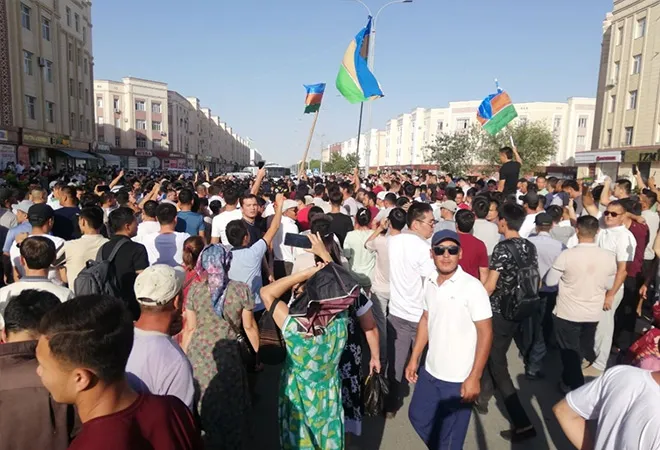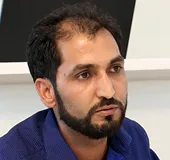-
CENTRES
Progammes & Centres
Location
The proposal to downgrade the autonomous status of Karakalpakstan has led to widespread protests in Uzbekistan.

On 1 July, violent protests swept Nukus, the capital of Karakalpakstan, following the downgrade of the autonomous status of this region by Uzbek President Shavkat Mirziyoyev. The ensuing violence killed at least 18 people and injured 243, including a few security officials. The Uzbek government detained 516 people, including leaders of the protestors. Deferring the decision to curtail the region’s autonomy in the wake of the widespread protests, President Mirziyoyev issued a decree to proclaim a state of emergency for a month in this autonomous region and curtailed internet services. The government justified its action “to ensure the security of citizens, defend their rights and freedoms and restore the rule of law and order”.
Deferring the decision to curtail the region’s autonomy in the wake of the widespread protests, President Mirziyoyev issued a decree to proclaim a state of emergency for a month in this autonomous region and curtailed internet services.
Historically, protests, dissent and criticism of the authoritarian regime are rare phenomena in Uzbekistan, as Mirziyoyev brought about economic and social changes, allowing more freedoms to the civil society.
Karakalpakstan and the Karakalpaks historically have an obscure origin. Their first historical reference came by the end of the 16th century. Loosely connected to the Khanate of Khiva, the Russians conquered the region in 1873. The Czars of Russia controlled the whole of Central Asia militarily for economic and political reasons. Following the Bolshevik Revolution in 1917, Turkistan became an autonomous Soviet Socialistic Republic in 1918, whereas Bukhara and Khiva (the two former protectorate states) were declared Peoples’ Republics in 1920.
Subsequently, Centre Asia saw resistance toward the erstwhile Soviet Union through pan-Islamic and pan-Turkic movements to create an independent pan-Islamic/pan-Turkic country. The Soviets used the colonial strategy of divide and rule in Centre Asia, twisting administrative units to divide ethnicities and create multiple minorities. The Soviets created these Socialist Soviet Republics (SSR) in Central Asia so that each republic had diverse ethnic groups, with nominal ethnicities falsely reflected in their names. In 1925, the Soviets created Karakalpak Autonomous Oblast, kept firstly within the Kazak SSR, then remained under the Russian Federation from 1930 to 1936. Subsequently, the Karakalpak Autonomous Oblast was made part of the Uzbekistan SSR in 1936 with an autonomous status. Others, like Tajik and Kyrgyz, became full SSRs in 1929 and 1936, respectively.
The Soviets used the colonial strategy of divide and rule in Centre Asia, twisting administrative units to divide ethnicities and create multiple minorities.
Rampant corruption, dwindling economic growth and a fall in supplies and exports posed grave challenges to the USSR after 1985. President Gorbachev introduced Glasnost and Perestroika, eventually leading to the Soviet Union's disintegration. The breakaway movements forced Russia’s first President Boris Yeltsin to make promises of total independence to the republics and unions of the USSR. The breakup of the USSR also brought independence to Karakalpakstan, and its parliament adopted a declaration of sovereignty in 1990. However, in 1993, the region was incorporated with Uzbekistan with a promise to get a referendum on independence after 20 years. Subsequently, Karakalpakstan had its unique symbols, institutions, and legal framework within Constitution of Uzbekistan, but the referendum never happened.
Karakalpakstan covers over 40 percent of Uzbekistan’s territory, where the combined population Karakalpaks and Kazaks outnumbered the ethnic Uzbeks. Their official language, though similar to Kazak, enjoys official status. The region’s economy is primarily agricultural; however, the living standards have deteriorated due to increased salination from 10/g to 100/g caused by the drying up of the Aral Sea. Rampant use of unsound agricultural practices during the Soviet era, including overuse of pesticides and chemicals to produce cotton, had impacted the region’s agricultural output and also the health of the people. The fisheries sector has vanished, and the harsh climate has shortened the growing season. The region, with poor infrastructure and a high level of unemployment, has become economically dependent on Uzbekistan. The per capita income of the people of this region lags behind the national average by 1.4 times. Furthermore, the poverty level is highest amongst the people of Karakalpakstan in Uzbekistan.
The region, with poor infrastructure and a high level of unemployment, has become economically dependent on Uzbekistan.
The increased salinity and toxic dust have led to widespread health hazards, including cancer, tuberculosis, and high levels of heart and kidney diseases among children. However, since 2016, Karakalpakstan has hugely benefitted from increased investments and the economic and social reforms brought about by President Mirziyoyev. These investments and reforms have gone beyond the capital Nukus. The Karakalpaks were generally happy with the autonomy given under the constitution, and even the centrifugal movements from outside Uzbekistan caused minimum anti-Mirziyoyev influence.
Following his election to the second term, President Mirziyoyev proposed drafting a new constitution to protect civil liberties. Soon after coming to power in 2016, he started a series of social and economic reforms, unleashing economic growth and foreign investment into the country. The economy and the civil society of the country became vibrant. For example, compared to other Central Asian Republics, Uzbekistan’s civil society is more active on social and electronic media. Mirziyoyev’s popularity increased as he revisited and repaired Uzbek relations with neighbours and reached out to the West.
The Karakalpaks were generally happy with the autonomy given under the constitution, and even the centrifugal movements from outside Uzbekistan caused minimum anti-Mirziyoyev influence.
The proposed constitutional amendments, which ignited the protests, were primarily meant to increase the president's term in office from five years to seven for Mirziyoyev. The present constitution limits the president to two five-year terms. Given Mirziyoyev's stature and popularity, the proposed constitutional amendment did not trigger any angry reaction from the people when it was made public in late June. However, the people were shocked when they realised that the proposed amendment also robbed Karakalpakstan of its autonomous status. The people fear this amendment will reset their status back to the Soviet era. The fury witnessed in Nukus proves they are ready to guard their hard-earned autonomy and independence, notwithstanding the costs of resistance.
The recent turn of events will make Tashkent nervous about the future, as significant gas reserves discovered in Karakalpakstan in 2018 have made the region an economic asset for Uzbekistan.
The views expressed above belong to the author(s). ORF research and analyses now available on Telegram! Click here to access our curated content — blogs, longforms and interviews.

Ayjaz Wani (Phd) is a Fellow in the Strategic Studies Programme at ORF. Based out of Mumbai, he tracks China’s relations with Central Asia, Pakistan and ...
Read More +